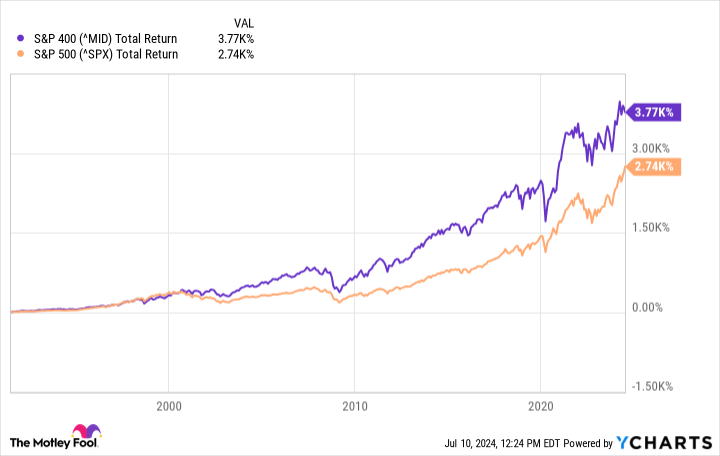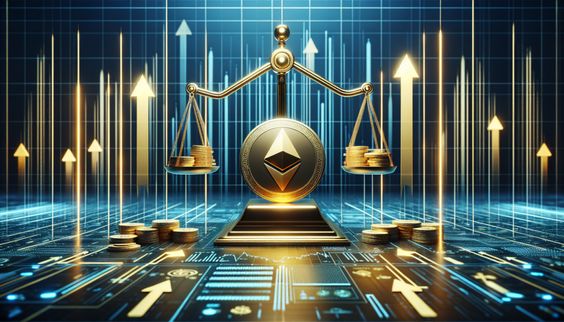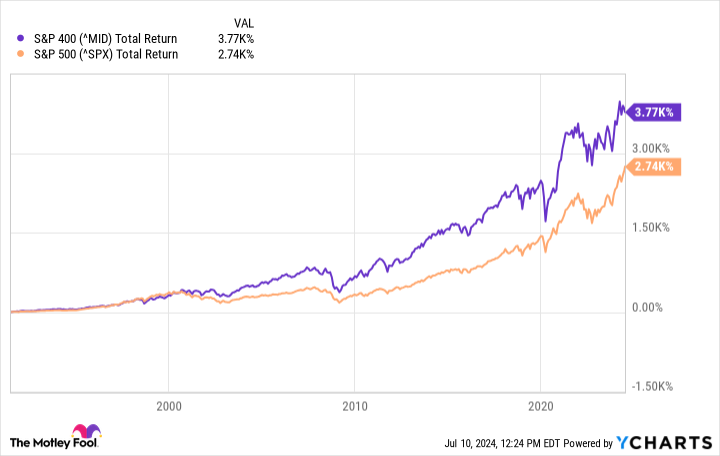ETFs
5 predictions for ETFs in the second half of 2024

Wall Street ended the first half of 2024 on a high note. The S&P 500 index gained 14.5%, while the Dow Jones Industrial Average advanced 3.8%. The Nasdaq Composite Index outperformed, climbing 18.1%.
The artificial intelligence (AI) hype, bets on lower rates and strong corporate earnings growth have been the main catalysts for the stock rally and will continue to do so for the rest of the year. Wall Street analysts have become more bullish on stocks, citing these factors as a strong combination.
Additionally, seasonality in stocks will prove beneficial if we look at history. In 1928, the S&P 500 index gained 10% or more at the midpoint for 29 years. By the end of the year, the average gain was 24%. According to Comerica Wealth Management, the S&P 500 index could gain another 10% by the end of 2024.
The upcoming recovery will be supported by some of the highlights of the first half of the year and a few new trends. Below, we have highlighted five trends that could influence the market over the remainder of the year.
“The Magnificent Seven” continues to grow
The “Mercenary Seven” are the main growth engine of the technology sector and the S&P 500 as a whole. They now represent 31% of the weight of the S&P 500. In the first half of the year, about 60% of the gains were generated by the “mega-cap” technology companies: NVIDIA (NVDA), Microsoft (MSFT), Amazon (AMZN), Meta Platforms (META) and Apple (AAPL). NVIDIA alone accounted for 31% of the market’s advance in the first half.
With this latest surge, NVIDIA, Apple and Microsoft are in the race to become the world’s most valuable company and reach a $4 trillion market cap on the back of growing enthusiasm for AI capabilities. This tech-driven momentum is likely to continue through at least the summer (read: Tech Sector Leads H1 Rally: Top 5 ETFs).
Roundhill Magnificent Seven ETF MAGS is the best bet to take advantage of the Magnificent Seven boom. It is the first-ever ETF that offers investors equal-weighted exposure to the Magnificent Seven stocks. MAGS has accumulated $578.3 million in its asset base and charges 29 bps in fees per year.
The rise of AI will continue
The rise of artificial intelligence will continue to fuel the recovery of the overall market, with companies investing heavily in the technology sector and beyond. The expansion of applications of artificial intelligence promises to open up new growth opportunities. According to a new report from Grand View Research, the global artificial intelligence market is expected to grow at a CAGR (2024-2030) of 36.6% to reach $811.75 billion by 2030.
Even though the technology seems to have become expensive, utilities remain an untapped area. AI is increasing the demand for electricity as data centers require tons of energy for computing and cooling. A simple ChatGPT task consumes 10 times more energy than a regular Google search. Thus, data centers with a capacity of 30 megawatts are increasing their capacity to handle 300 megawatts of electricity. This has made the traditional utility sector of the market the most attractive (read: ETFs to Make the Most of the AI-Powered Utility Sector).
Investors looking to capitalize on the next phase of the AI industrial revolution should consider utilities sector ETFs. Utilities Select Sector SPDR (XLU) is one of the most popular and largest ETFs in the sector, with $13.8 billion in AUM. It seeks to provide exposure to companies in the electric utilities, water utilities, multiple utilities, independent power and renewable power producers, and gas utilities sectors. XLU tracks the Utilities Select Sector Index, charging 9 bps in annual fees. It has a Zacks ETF Rank #3 (Hold).
The story continues
Rate cuts in sight
At the last FOMC meeting, U.S. policymakers forecast one rate cut this year and four cuts by 2025. The Fed amended the wording of its statement, stressing that there had been “modest further progress toward the Committee’s 2 percent inflation target.” Previously, the statement had stressed a “lack” of further progress.
The latest data points to a slowing economy, raising fresh hopes for a rate cut in September. The U.S. services sector contracted at its fastest pace in four years in June. Traders are now pricing in a 74% chance of a rate cut in September, according to the CME’s FedWatch tool. Low rates reduce the cost of borrowing, which is often needed to finance business expansion, thereby boosting growth. That can have a positive impact on sectors like real estate, consumer discretionary and financials, which are typically sensitive to interest rate changes (read: Sector ETFs Benefit from Rising Rate Cut Bets).
In the real estate sector, lower rates can boost housing market activity by making mortgages more affordable. For consumer discretionary sectors, lower borrowing costs can lead to increased consumer spending. In the financial sector, while lower rates can squeeze banks’ net interest margins, they can also encourage lending and potentially lead to increased lending activity to consumers and businesses.
Therefore, investors could bet on one of these sectors to amplify their gains for the rest of the year. Some of the top-ranked ETFs are VanEck Retail ETF RTH and Selected Financial Sector SPDR ETFs XLF.
Individual Stock ETFs Remain Popular
Single-stock ETFs have gained popularity over the past year, amid a surge in stock markets and the tech boom. Unlike traditional ETFs, which typically track a broad index or sector, single-stock ETFs provide exposure to the performance of a specific company using derivatives. This allows investors to gain exposure to a particular stock without having to buy it directly.
According to Morningstar data, there are currently four dozen individual stock ETFs on the market, with a combined $3.5 billion in assets. Five companies—AXS, Direxion, YieldMax, GraniteShares, and Innovator—offer all of the individual stock ETFs currently available on the market.
ETF T-REX 2X Long NVIDIA Daily Target NVDX and GraniteShares 2x Long META Daily ETF FBL is the big winner, up 449.5% and 75.7% respectively. NVDX offers two times (200%) the daily percentage change of NVIDIA common stock, while FBL tracks two times the performance of Meta Platforms shares.
Elections to increase market volatility
Stock market volatility is expected to intensify as the United States heads to the polls to elect the next president on November 5.
Former President Donald Trump has widened his lead over President Joe Biden in two major polls following the first 2024 presidential debate. Trump leads Biden by six points in a new New York Times/Siena College poll, a three-point swing in Trump’s favor since a poll a week earlier. It’s also Trump’s largest lead in any poll conducted by the groups since he launched his first presidential campaign in 2015. A Wall Street Journal poll also found Biden trailing Trump by six points, the largest lead Trump has had over Biden in the Journal’s polls since 2021 in a two-person contest, and a four-point increase in Trump’s lead since February.
In such a scenario, dividend investing seems to be the best choice as it offers a steady and safe income. The strategy does not offer spectacular price appreciation but is a major source of steady income for investors in any market. Top-ranked dividend ETFs like Vanguard Dividend Appreciation ETF VIG, Vanguard High Dividend Yield ETF VYM and iShares Core Dividend Growth ETF DGROs seem to be interesting choices (read: Guide to the 10 most popular dividend ETFs).
Want to know the latest recommendations from Zacks Investment Research? Download the 7 Best Stocks for the Next 30 Days today. Click to get this free report
ETF SPDR Financial Select Sector (XLF): ETF Research Reports
VanEck Retail ETF (RTH): ETF Research Reports
Vanguard Dividend Appreciation ETF (VIG): ETF Research Reports
Vanguard High Dividend Yield ETF (VYM): ETF Research Reports
iShares Core Dividend Growth ETF (DGRO): ETF Research Reports
Roundhill Magnificent Seven ETF (MAGS): ETF Research Reports
GraniteShares 2x Long META Daily ETF (FBL) : ETF Research Reports
ETF T-REX 2X Long NVIDIA Daily Target (NVDX): ETF Research Reports
ETFs
Missed the Bull Market Resumption? 3 ETFs to Help You Build Wealth for Decades

The market’s rebound from the 2022 bear market was not only unexpected. It was also bigger than expected. S&P 500 The stock price is up 60% from the bear market low, despite no clear signs at the time that such a rally was in the works. Chances are you missed at least part of this current rally.
If so, don’t be discouraged: you’re in good company. You’re also far from financially ruined. While you can’t go back and make up for the missed opportunity, for long-term investors, the growth potential is much greater.
If you want to make sure you don’t miss the next big bull run, you might want to tweak your strategy a bit. This time around, you might try buying fewer stocks and focusing more on exchange traded funds (or ETFs), which are often easier to hold when things get tough for the overall market.
With that in mind, here’s a closer look at three very different ETFs to consider buying that could – collectively – complement your portfolio brilliantly.
Let’s start with the basics: dividend growth
Most investors naturally favor growth, choosing growth stocks to achieve that goal. And the strategy usually works. However, most long-term investors may not realize that they can get the same type of net return with boring dividend stocks like the ones held in the portfolio. Vanguard Dividend Appreciation ETF (NYSEMKT: VIG) which reflects the S&P US Dividend Growth Index.
As the name suggests, this Vanguard fund and its underlying index hold stocks that not only pay consistent dividends, but also have a history of consistently increasing dividends. To be included in the S&P US Dividend Growers Index, a company must have increased its dividend every year for at least the past 10 years. In most cases, however, they have been doing so for much longer.
The ETF’s current dividend yield of just under 1.8% isn’t exactly exciting. In fact, it’s so low that investors might wonder how this fund is keeping up with the broader market, let alone growth stocks. What’s being grossly underestimated here is the sheer magnitude of these stocks. dividend growthOver the past 10 years, its dividend per share has nearly doubled, and more than tripled from 15 years ago.
The reason is that solid dividend stocks generally outperform their non-dividend-paying counterparts. Calculations by mutual fund firm Hartford indicate that since 1973, S&P 500 stocks with a long history of dividend growth have averaged a single-digit annual return, compared with a much more modest 4.3% annual gain for non-dividend-paying stocks, and an average annual return of just 7.7% for an equal-weighted version of the S&P 500. The numbers confirm that there’s a lot to be said for reliable, consistent income.
The story continues
Then add capital appreciation through technology
That said, there’s no particular reason why your portfolio can’t also hold something a little more volatile than a dividend-focused holding. If you can stomach the volatility that’s sure to continue, take a stake in the Invesco QQQ Trust (NASDAQ: QQQ).
This Invesco ETF (often called the “cubes” or the triple-Q) is based on the Nasdaq-100 index. Typically, this index consists of 100 of the Nasdaq Composite IndexThe index is one of the largest non-financial indices at any given time. It is updated quarterly, although extreme imbalance situations may result in unplanned rebalancing of the index.
That’s not what makes this fund a must-have for many investors, though. It turns out that most high-growth tech companies choose to list their shares through the Nasdaq Sotck exchange rather than other exchanges like the New York Stock Exchange or the American Stock ExchangeNames like Apple, MicrosoftAnd Nvidia are not only Nasdaq-listed securities. They are also the top holdings of this ETF, with Amazon, Meta-platformsand Google’s parent company AlphabetThese are of course some of the highest-yielding stocks on the market in recent years.
This won’t always be the case. Just as companies like Nvidia and Apple have squeezed other names out of the index to make room for their stocks, these current names could also be replaced by other names (although it will likely be a while before that happens). It’s the proverbial life cycle of the market.
This shift, however, will likely be driven by technology companies that are offering revolutionary products and services. Owning a stake in the Invesco QQQ Trust is a simple, low-cost way to ensure you’re invested in at least most of their stocks at the perfect time.
Don’t forget indexing, but try a different approach
Finally, while Triple-Q and Vanguard Dividend Appreciation funds are smart ways to diversify your portfolio over the long term, the good old indexing strategy still works. In other words, rather than risk underperforming the market by trying to beat it, stick to tracking the long-term performance of a broad stock index.
Most investors will opt for something like the SPDR S&P 500 Exchange Traded Fund (NYSEMKT:SPY), which of course mirrors the large-cap S&P 500 index. And if you already own one, great: stick with it.
If and when you have some spare cash to put to good use, consider starting a mid-cap funds as the iShares Core S&P Mid-Cap ETF (NYSEMKT: IJH) instead. Why? Because you’ll likely get better results with this ETF than you will with large-cap index funds. Over the past 30 years, S&P 400 Mid-Cap Index significantly outperformed the S&P 500.
^MID Chart
The disparate degree of gains actually makes sense. While no one disputes the solid foundations on which most S&P 500 companies are built, they are in many ways victims of their own size: It’s hard to get bigger when you’re already big. This is in contrast to the mid-cap companies that make up the S&P 400 Mid Cap Index. These organizations have moved past their rocky, shaky early years and are just entering their era of high growth. Not all of them will survive this phase, but companies like Advanced microsystems And Super microcomputer Those that survive end up being incredibly rewarding to their patient shareholders.
Should You Invest $1,000 in iShares Trust – iShares Core S&P Mid-Cap ETF Right Now?
Before purchasing shares of iShares Trust – iShares Core S&P Mid-Cap ETF, consider the following:
The Motley Fool Stock Advisor analyst team has just identified what they believe to be the 10 best stocks Investors should buy now…and the iShares Trust – iShares Core S&P Mid-Cap ETF wasn’t one of them. The 10 stocks selected could generate monstrous returns in the years to come.
Consider when Nvidia I made this list on April 15, 2005… if you had $1,000 invested at the time of our recommendation, you would have $791,929!*
Stock Advisor provides investors with an easy-to-follow blueprint for success, including portfolio construction advice, regular analyst updates, and two new stock picks each month. The Stock Advisor service offers more than quadrupled the return of the S&P 500 since 2002*.
*Stock Advisor returns as of July 8, 2024
John Mackey, former CEO of Amazon’s Whole Foods Market, is a member of The Motley Fool’s board of directors. Randi Zuckerberg, former director of market development and spokesperson for Facebook and sister of Meta Platforms CEO Mark Zuckerberg, is a member of The Motley Fool’s board of directors. Suzanne Frey, an executive at Alphabet, is a member of The Motley Fool’s board of directors. James Brumley has positions in Alphabet. The Motley Fool has positions in and recommends Advanced Micro Devices, Alphabet, Amazon, Apple, Meta Platforms, Microsoft, Nvidia, and Vanguard Specialized Funds – Vanguard Dividend Appreciation ETF. The Motley Fool recommends Nasdaq and recommends the following options: long January 2026 $395 calls on Microsoft and short January 2026 $405 calls on Microsoft. The Motley Fool has a position in Advanced Micro Devices, Alphabet, Amazon, Apple, Meta Platforms, Microsoft, Nvidia, and Vanguard Specialized Funds – Vanguard Dividend Appreciation ETF. The Motley Fool recommends Nasdaq and recommends the following options: long January 2026 $395 calls on Microsoft and short January 2026 $405 calls on Microsoft. disclosure policy.
Missed the Bull Market Resumption? 3 ETFs to Help You Build Wealth for Decades was originally published by The Motley Fool
ETFs
This Simple ETF Could Turn $500 a Month Into $1 Million

This large-cap ETF offers investors the potential for above-market returns while minimizing risk.
It’s always inspiring to hear stories of people who invested in a company and made tons of money as the company grew and became successful. While these stories are a testament to the power of investing, they can also be misleading. That’s not because it doesn’t happen often, but because you don’t have to make a big splash on a single company to make a lot of money in the stock market.
Invest regularly in exchange traded funds (AND F) is a great way to build wealth. ETFs allow you to invest in dozens, hundreds, and sometimes thousands of companies in a single investment. For investors looking for an ETF that can help them become millionaires, look no further than the Vanguard Growth ETFs (VUG 0.61%).
A history of outperforming the market
Since its launch in January 2004, this ETF has outperformed the market (based on S&P 500 Back), with an average total return of around 11.6%. The returns are even more impressive when looking back over the past decade, with the ETF posting an average total return of around 15.7%.
Total VUG Performance Level data by YCharts
The ETF’s past success doesn’t mean it will continue on this path, but for the sake of illustration, let’s take a middle ground and assume it averages about 13% annual returns over the long term. Averaging those returns, monthly investments of $500 could top the $1 million mark in just over 25 years.
Assuming (emphasis on the word “assume”) that the ETF continues to generate an average total return of 15.7% over the past decade, investing $500 a month could get you past $1 million in about 23 years. At an annual return of 11.6%, that would take nearly 28 years.
There is no way to predict the future performance of the ETF, but the most important thing is the power of time and Compound profit. Earning $1 million by saving alone is a difficult and unachievable task for most people. However, it becomes much more achievable if you give yourself time and make regular investments, no matter how small.
So why choose the Vanguard Growth ETF?
This ETF can offer investors the best of both worlds. On the one hand, since it only contains large cap stocksIt offers more stability and less volatility than you typically find with smaller growth stocks. At the other end, the focus on growth means it is built with the goal of outperforming the market.
Investing involves a tradeoff between risk and return, and this ETF falls somewhere in the middle for the most part. That’s not just because it only contains large-cap stocks. It’s also because large-cap stocks are leading the way. Here are the ETF’s top 10 holdings:
- Microsoft: 12.60%
- Apple: 11.51%
- Nvidia: 10.61%
- Alphabet (both share classes): 7.54%
- Amazon: 6.72%
- Meta-platforms: 4.21%
- Eli Lilly: 2.88%
- You’re here: 1.98%
- Visa: 1.72%
The Vanguard Growth ETF is not as diversified as other broad ETFs, with the top 10 holdings making up nearly 60% of the fund and the “The Magnificent Seven” with stocks accounting for about 55%. However, many of these companies (particularly mega-cap technology stocks) have been among the best performers in the stock market over the past decade and still have great growth opportunities ahead of them.
MSFT Total Return Level data by YCharts
Big tech stocks are expected to continue to see growth in areas such as cloud computing, artificial intelligenceand cybersecurity; Eli Lilly will benefit from advances in biotechnologyTesla is one of the leaders in electric vehicles, which are still in the early stages of development; and Visa is expected to be one of the forerunners as the world moves toward more digital payments.
ETF concentration adds risk, especially if Microsoft, Apple or Nvidia is experiencing a slowdownBut these companies are well positioned to drive long-term growth despite any short-term setbacks that may arise. Consistent investments over time in the Vanguard Growth ETF should pay off for investors.
Randi Zuckerberg, former head of market development and spokesperson for Facebook and sister of Meta Platforms CEO Mark Zuckerberg, is a member of The Motley Fool’s board of directors. Suzanne Frey, an executive at Alphabet, is a member of The Motley Fool’s board of directors. John Mackey, former CEO of Whole Foods Market, an Amazon subsidiary, is a member of The Motley Fool’s board of directors. Stefon Walters has positions in Apple and Microsoft. The Motley Fool has positions in and recommends Alphabet, Amazon, Apple, Meta Platforms, Microsoft, Nvidia, Tesla, Vanguard Index Funds-Vanguard Growth ETF, and Visa. The Motley Fool recommends the following options: long January 2026 $395 calls on Microsoft and short January 2026 $405 calls on Microsoft. The Motley Fool has a position in shares of Apple and Microsoft. disclosure policy.
ETFs
Ethereum ETFs Could Bring in $1 Billion a Month

In a recent interview with Bloomberg, Kraken’s chief strategy officer Thomas Perfumo predicted that Ethereum ETFs could attract between $750 million and $1 billion in monthly investments.
“Market sentiment is being priced in. I think the market has priced in something like $750 million to $1 billion of net inflows into Ethereum ETF products each month,” Perfumo said.
In the interviewPerfumo noted that if inflows exceed expectations, it could provide strong support to the industry and potentially drive Ethereum to new record highs.
This creates positive support for the industry, if we go beyond that, note that Bitcoin was at a rate above $2.5 billion
He said
Moreover, the hype around Ethereum ETFs has already sparked some optimism among investors. After the SEC approved the 19b-4 filing, Ethereum’s price jumped 22%, attracting investment into crypto assets.
This price movement shows how sensitive the market is to regulatory changes and the growth potential once ETFs are approved.
Perfumo also highlighted other factors supporting current market sentiment, including the upcoming US elections and a potential interest rate cut by the Federal Reserve. Recent US CPI data suggests disinflation on a monthly and annual basis, with some traditional firms predicting rate cuts as early as September.
These broader economic factors, combined with developments in the crypto space, are shaping the overall market outlook.
Regarding Kraken’s strategy, Perfumo highlighted the exchange’s goal of driving cryptocurrency adoption through strategic initiatives. When asked about rumors of Kraken going public, he reiterated that the company’s intention is instead to broaden cryptocurrency adoption.
Read also : Invesco, Galaxy Cut Ether ETF Fees to 0.25% in Competitive Market
ETFs
Kraken Executive Expects Ethereum ETF Launch to “Lift All Boats”

Kraken Chief Strategy Officer Thomas Perfumemo said: Ethereum ETFs (ETH) could help the crypto sector while commenting on political developments in the United States.
On July 12, Perfumo told Bloomberg that spot Ethereum ETFs would attract capital flows while drawing attention to crypto, noting:
“It’s a rising tide, which lifts the whole history of the boat.”
Perfumo further explained that the final value of Ethereum “depends on the Ethereum ETF.”
He said the cryptocurrency market is “pricing in” between $750 million and $1 billion in net inflows into Ethereum products on a monthly basis, which would imply that Ethereum could reach all-time highs between $4,000 and $5,000.
Perfumo also compared expectations to Bitcoin’s all-time high in March, which he called a “silent spike” that occurred without any evidence of millions of new investors entering the industry.
Political evolution
Perfumo also commented on political developments. At the beginning of the interview, he said that the results of the US elections “will set the tone for policymaking and the legislative agenda for the next four years.”
He also stressed the importance of legislative action and clarity and noted that recent developments show bipartisan support in Congress.
The House recently voted to pass the Financial Innovation and Technology for the 21st Century Act (FIT21) and attempted to repeal controversial SEC accounting rules with the Senate. However, the president Joe Biden Chosen to veto The resolution.
Perfume said:
“Even if you encounter obstacles at the executive level, [there’s] “There is still good progress to come.”
He added that the Republican Party appears “more pro-crypto.” [and] “more progressive” on the issue, noting Donald Trump plans to attend the Bitcoin Conference in Nashville.
Trump has also made numerous statements in support of pro-crypto policy, including at recent campaign events in Wisconsin And San Francisco.
Mentioned in this article
-

 DeFi12 months ago
DeFi12 months agoSwitchboard Revolutionizes DeFi with New Oracle Aggregator
-

 News1 year ago
News1 year agoLatest Business News Live Updates Today, July 11, 2024
-

 DeFi12 months ago
DeFi12 months agoIs Zypto Wallet a Reliable Choice for DeFi Users?
-

 DeFi1 year ago
DeFi1 year ago👀 Lido prepares its response to the recovery boom
-

 Fintech12 months ago
Fintech12 months agoFinTech LIVE New York: Mastercard and the Power of Partnership
-

 DeFi12 months ago
DeFi12 months agoEthena downplays danger of letting traders use USDe to back risky bets – DL News
-

 Fintech1 year ago
Fintech1 year ago121 Top Fintech Companies & Startups To Know In 2024
-

 ETFs1 year ago
ETFs1 year agoGold ETFs see first outing after March 2023 at ₹396 cr on profit booking
-

 Fintech1 year ago
Fintech1 year agoFintech unicorn Zeta launches credit as a UPI-linked service for banks
-

 News1 year ago
News1 year agoSalesforce Q1 2025 Earnings Report (CRM)
-

 DeFi1 year ago
DeFi1 year agoTON Network Surpasses $200M TVL, Boosted by Open League and DeFi Growth ⋆ ZyCrypto
-

 ETFs1 year ago
ETFs1 year agoLargest US Bank Invests in Spot BTC ETFs While Dimon Remains a Bitcoin Hater ⋆ ZyCrypto



















